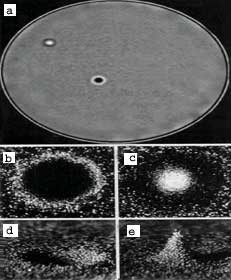The grain of the matter
 pattern formation in nature is an almost universal phenomenon, be it biological, like patterns on animals or geological, like striations in rock formations. Though the physical interactions leading to development of patterns may differ, the evolution and dynamics of patterns could be provided an universal mathematical description. Paul Umbanhowar and his colleagues at the Centre for Nonlinear Dynamics and the department of physics at the University of Texas in Austin, us , have reported a new kind of structure which emerges from the behaviour of a layer of minute brass balls that are excited in a certain fashion. Strange but well-defined structures are displayed when the exciting force reaches a critical value. Though observed only in this system comprising of a sand-like layer of metallic balls, the discovery is important in that it may be relevant for a whole variety of different non-linear systems ( Nature , Vol 382, No 6594).
pattern formation in nature is an almost universal phenomenon, be it biological, like patterns on animals or geological, like striations in rock formations. Though the physical interactions leading to development of patterns may differ, the evolution and dynamics of patterns could be provided an universal mathematical description. Paul Umbanhowar and his colleagues at the Centre for Nonlinear Dynamics and the department of physics at the University of Texas in Austin, us , have reported a new kind of structure which emerges from the behaviour of a layer of minute brass balls that are excited in a certain fashion. Strange but well-defined structures are displayed when the exciting force reaches a critical value. Though observed only in this system comprising of a sand-like layer of metallic balls, the discovery is important in that it may be relevant for a whole variety of different non-linear systems ( Nature , Vol 382, No 6594).
For their experiment, Umbanhowar and his colleagues used an evacuated, upright and cylindrical container, driven in the vertical direction at a known frequency. A granular material (in this case, brass balls) was spread at the bottom of the container. These macroscopic grains can interact only by means of contact forces which means that each ball can interact only with another with which it is in contact. Previously, the same group had discovered that depending on the strength of the excitation, many interesting structures like squares or hexagons form in the layer, with sizes which are many times the size of the grain itself. In the present experiment, the team has observed a different kind of structure which it calls the oscillon. Oscillons are highly localised, particle-like excitations which are stable and have an oscillating frequency which is exactly half the driving frequency. Furthermore, there are two kinds of oscillons and these can interact to form chains and other patterns. Although they do not propagate, they do drift slowly and randomly in the container.
Granular media, used to observe oscillons, are known to have peculiar properties which are still not completely understood. But such media do exhibit properties typical to both solids and liquids. For instance, sand can heap unlike a liquid and once heaped, could collapse and start flowing if the amount of sand is greater than a certain critical value. Interestingly, only a thin layer near the surface flows while the rest of the heap remains in place.
Also, granular media are dissipative. Therefore, some source of energy is needed to maintain movement. A layer of sand is an example of a dissipative non-linear system which can be driven to various states. In the case of most systems, once the driving force exceeds a critical value, they undergo abrupt changes called bifurcations which are characterised by a well-defined mode. As the force increases, the system undergoes further bifurcations.
However, dissipation in such systems is global and not confined to a single region in the system. But there are numerous examples of non-linear systems which have highly localised structures called solitons. Solitons are stable and are observed in many non-linear systems (for instance, light waves in a fiber optic cable), whose characteristic is little or no dissipation. The experiment of Umbanhowar and his team indicates that such localised, stable structures could occur in dissipative media like sand as well. In fact, the dissipative nature of the media seems to be essential for the formation of these structures. Though such structures have only been observed in this particular system, it is believed that they could be universal.
Interestingly, scientists have recently observed propagating localised states in highly dissipative fluids. The discovery of oscillons, which resemble the states found in fluids, has encouraged researchers to believe in a possible connection between the two. It is hoped that we will soon have a proper theory of oscillons that would lead to a better understanding of the fundamental nature of granular systems.
Related Content
- Forty-Fourth Report (Seventeenth Lok Sabha) on ‘Fertilizer Subsidy Policy and Pricing matters including need to continue Urea Subsidy Scheme’ pertaining to the Department of Fertilizers, Ministry of Chemicals and Fertilizers
- The order of the National Green Tribunal regarding setting up of a ethanol plant at village Banana, cuttack district, Odisha, 12/06/2023
- Report on pollution caused due to loading and unloading of cement form a railway good shed, Itarsi, Madhya Pradesh, 03/01/2023
- Order of the National Green Tribunal regarding biological pollution by the Susri insects, 31/10/2022
- Judgement of the Supreme Court of India regarding schemes to alleviate the sufferings of the migrant labourers/workers, 29/06/2021
- Order of the High Court of Punjab and Haryana regarding hampering of food grains movement due to farmers agitation, Ferozepur, Punjab, 18/06/2021
